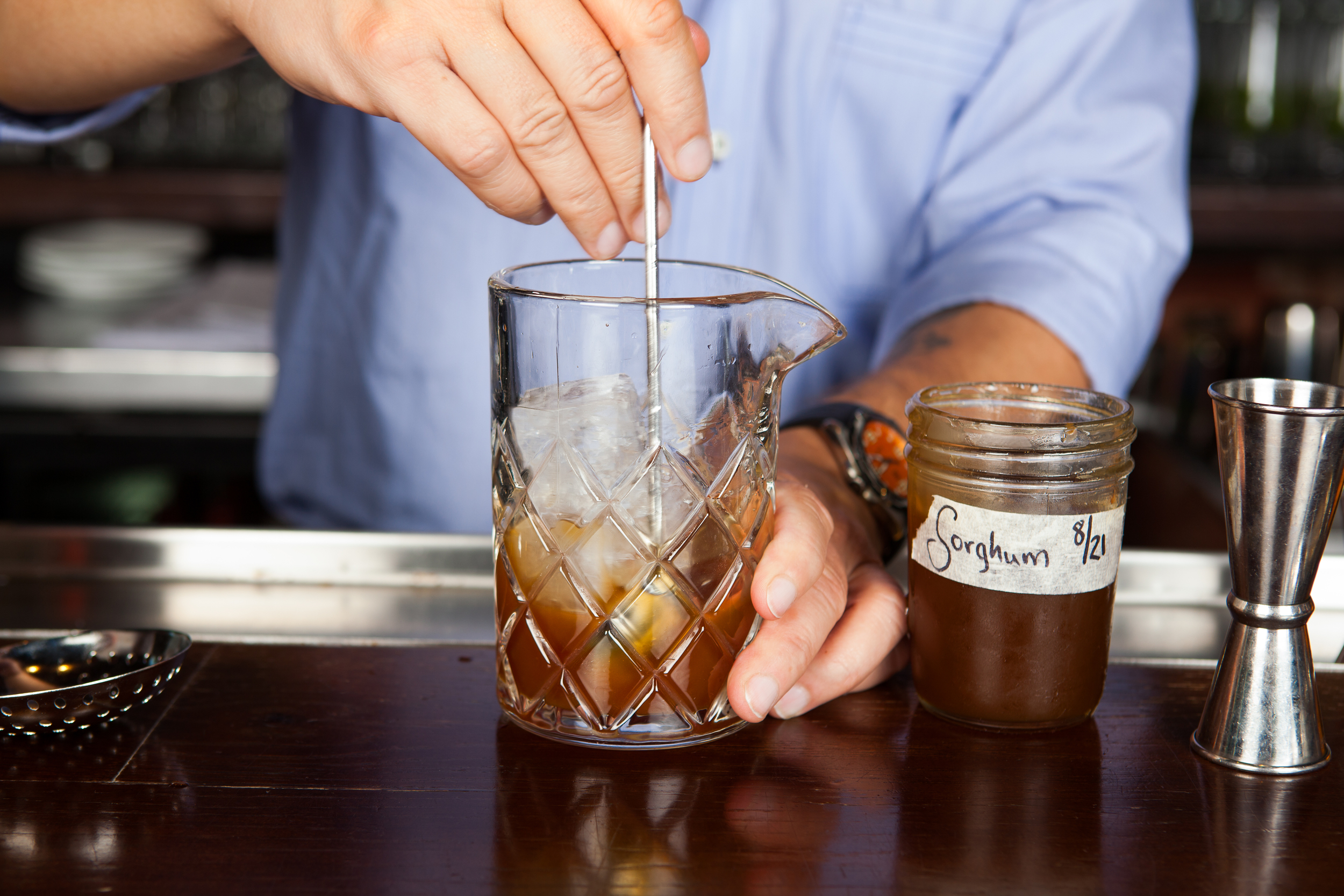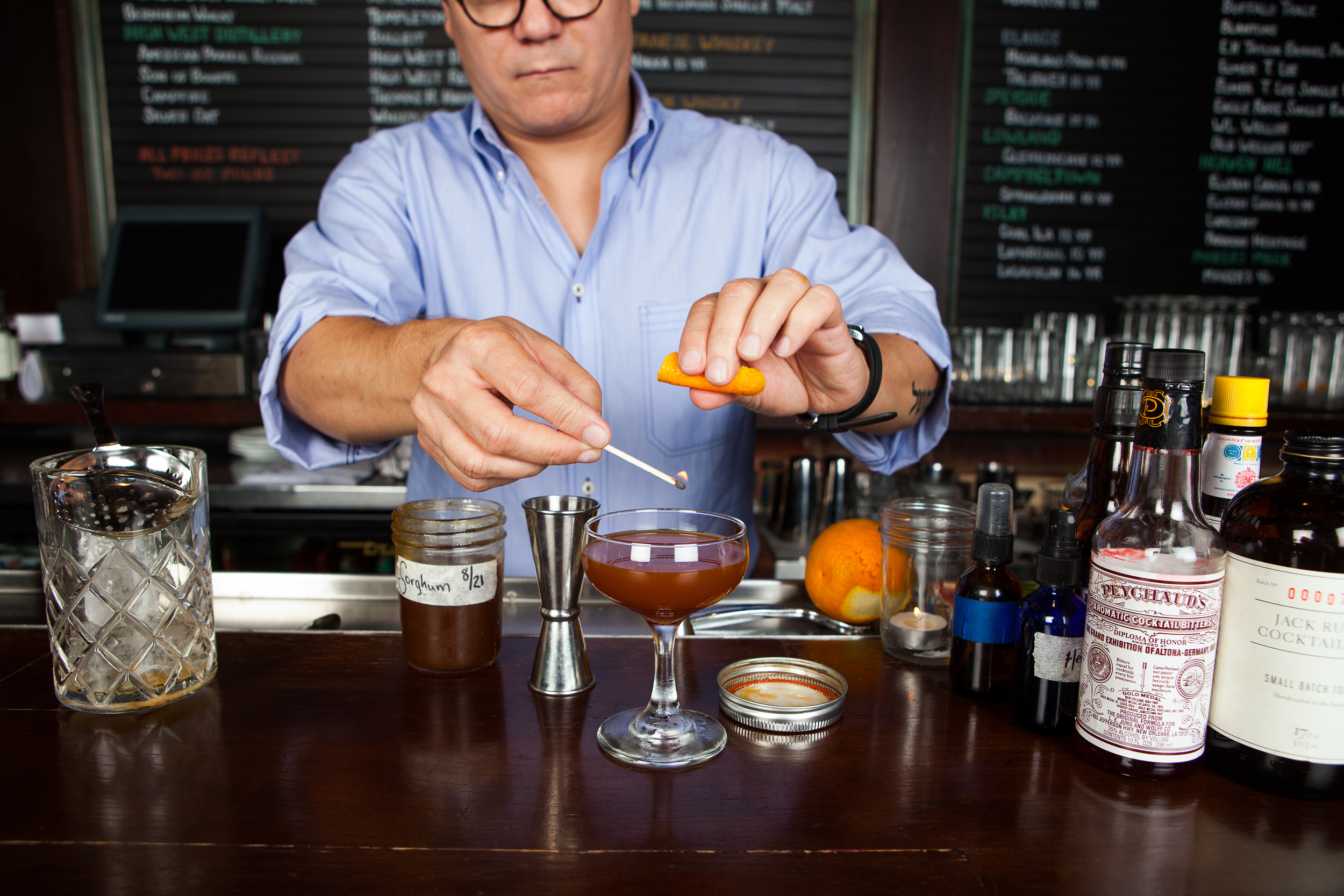The numbered recipe is one of cocktail culture’s great traditions.
If you know a little about classic cocktails, probably the first numbered drink you’d think of is the Corpse Reviver, of which the most popular is the Corpse Reviver No. 2 — a potent blend of gin, Cointreau, Lillet Blanc, lemon juice and absinthe that will, in fact, revive your sorry ass.
Here at The Bitter Southerner, we believe that part of our job is to invent a few new Southern traditions. We figure there’s no reason our generation can’t come up with some good ones. A few things that serve to tip the scales, a little at a time, in the right direction. So we came up with an idea. We would challenge some of our favorite Southern bartenders to create a cocktail called The Bitter Southerner. We’d collect them, and number them, over time creating a whole family of cocktails, each reflecting its creator’s unique skills and perspectives on the South.
We are now proud to present,
If anybody’s earned the stripes to take on the challenge of creating The Bitter Southerner No. 1, it’s Jerry Slater, the owner and barkeep of one of Atlanta’s best whiskey haunts, H. Harper Station. Slater served two stints over seven years behind the legendary bar at the Seelbach Hotel in Louisville, Ky. It is arguably the grandest Southern temple of tippling.
The Seelbach dates to 1905. Like many old hotel bars, it’s a place of dark paneling and woolen carpets so plush they’ll absorb the shock of the poor soul who stays too long and falls off the stool. But the Seelbach also has the good fortune of being in the heart of Kentucky’s bourbon country. It’s a place where mere mortals can taste things like the impossible-to-find Van Winkle Family Reserve rye (remember the Resurgens?). For whiskey geeks, a trip to the Old Seelbach Bar is like a wine nut getting to visit Château Latour for barrel samples, or a beer geek trekking to Westvleteren for Trappist ales.
“I got really immersed in the bourbon culture,” Slater says of his time at the Seelbach. “It gave me an appreciation of whiskey.”
But even for someone with Slater’s depth of knowledge, the challenge of creating a cocktail can be daunting. It’s a very different thing from improvising a new meal in a kitchen. Think about it this way: Assume that you go to your local farmer’s market and pick up some good, ripe Arkansas Traveler tomatoes. And maybe you’re able to score a quarter-pound of Cyprus cheese from Sweet Grass Dairy down in Thomasville, Ga., a beautiful semisoft creation infused with olives, sun-dried tomatoes, garlic and basil.
You take those two things home and think, “Hmm. Let’s slice these tomatoes and that cheese. Drizzle some vinegar and oil on the slices. Little salt and pepper.”
Once you get that plate arranged, you take it out to your friends on the front porch, and they dig in. They love it. They’re happy. They might ask you where the tomatoes and the cheese came from. But they will not ask you this:
“What do you call it?”
Because, after all, what would you answer? “Tomatoes and cheese”? You could, of course, come up with the full-on, restaurant-menu description, and say something like, “It’s called Local Arkansas Traveler Tomatoes With Sweet Grass Cyprus Cheese, Balsamic and Olive Oil.”
Yeah, you could do that. But your friends on the front porch would laugh at you.
Cocktails are a different story. People expect them to have names. So when we ask a bartender to create a drink called The Bitter Southerner, the bartender begins asking himself or herself questions. What would a Bitter Southerner taste like? What ingredients embody that name? What goes with what?
Slater says the process is analogous to the experience he’s heard his favorite songwriters describe.
“Sometimes you wake up and it’s all right there, and sometimes you have to work really hard on it,” he says. The basic cocktail formal is simple. Spirit + Bitter + Sweet = Cocktail. But there are thousands of different choices in each category. We’ll defer to our statistician friends to tell us exactly how many possible combinations there are, but it’s a really big number.
When we first asked him to create The Bitter Southerner No. 1, Slater already had a cocktail on the H. Harper Station menu that referenced a Southern icon: a drink called God’s Little Acre, inspired by Erskine Caldwell’s groundbreaking 1933 novel of the same name. So when we proposed something called The Bitter Southerner, he says he asked himself, “What’s the roughest, toughest thing we can come up with?” He says he imagined Yosemite Sam. He wanted something rootin’, tootin’.
For the spirit (and the Southerner) part, Slater went directly to a Kentucky icon, the legendary distiller Booker Noe, for his dense, lovely, barrel-proof Booker’s bourbon.
Slater says The Bitter Southerner No. 1 depends on high-proof bourbon such as Booker’s.
The late Mr. Noe, longtime master distiller at the Jim Beam distillery in Clermont, Ky., liked his whiskey strong. His creation is a cask-strength (or barrel-proof) bourbon, meaning it isn’t diluted when it comes out of the barrel. Every batch of Booker’s is slightly different, but you’ll see most bottles labeled with a proof of between 121 and 130. Few bourbons are that strong unless you move up into the super-expensive cask-strength choices such as George T. Stagg and William Larue Weller. Noah’s Mill, made at just over 114 proof by The Willett Distilling Company in Bardstown, is the only comparable we’ve found in the same price range as Booker’s.
But unlike the Resurgens we mentioned a couple of weeks ago, you can make The Bitter Southerner No. 1 at home. So if you want to, we recommend that you try to find $50 you can spare on a bottle of Booker’s. Booker’s is the big, beating heart of The Bitter Southerner No. 1.
If you don’t like the stuff, holler at us. We’ll gladly take whatever’s left in your bottle off your hands.
With thoughts of Yosemite Sam in his head, Slater says his mind immediately went to Fernet Branca, an Italian herbal liqueur. Bartenders swear by the power of this stuff.
They describe it like it was some miracle cure. It was created in 1845 as a digestif, a tonic to settle the stomach. The manufacturer keeps the recipe secret, of course, but does confirm that it contains aloe from South Africa, rhubarb from China, gentian from France, galangal from India or Sri Lanka, chamomile from Italy and Argentina, saffron, myrrh and elderflower. Put them all together, and you have something dark, syrupy and mysterious, about 40 percent alcohol by volume. San Francisco writer Nate Cavalieri once described Fernet Branca’s smell as “black licorice-flavored Listerine.”
Throw in those Fee Bros. Whiskey-Barrel Aged Bitters, and you've definitely got the bitter part covered.
Slater gave The Bitter Southerner No. 1 its sweetness from another Southern ingredient: sorghum.
But let’s be clear. Sorghum has certainly been a staple in the South for many years, but it wasn’t truly native to the American South. Sorghum is uniquely African. Like so many other Southern staples, sorghum is an undeserved gift, brought here first by enslaved Africans who carried the seeds to America in their pockets.
When we tell you to sweeten this drink with sorghum, be careful not to use the full-strength stuff. Sorghum is so thick, it would just gum up your mixing glass. So you have to make something called “sorghum mix.”
To make the sorghum mix, heat equal parts water and sorghum syrup over medium heat, stirring until they come together. Let it cool completely on the stovetop and then funnel it into a bottle.
To make The Bitter Southerner, one could theoretically just put 3/8 ounce of water and 3/8 ounce of sorghum into a glass measuring cup and put that in the microwave, then stir it up and dump it into the drink after it cools. But we recommend you go analog on this one. Go ahead and make a small batch — eight to 12 ounces total. We swear you’ll wind up using the rest. Store it in the fridge.
Southerners don’t lead the so-called “simple life” in the same way that, say, New Englanders would think of the simple life. Our simple life has to have a little show in it. I could prattle on about how this is evidenced in clothing, art and such, but let’s just say this: There ain’t no Mardi Gras in Bangor.
So this drink needed a little show, and Jerry Slater gave it one: fire. The flamed orange peel is the pièce de résistance of The Bitter Southerner No. 1.
If you’ve never flamed an orange peel, here’s how. Use a paring knife or a peeler to cut a wide strip of orange peel. Hold the peel over a flame for a second or two to warm it. Then hold the edges of the peel with your thumb and forefingers. Hold a flame in your other hand between the surface of the drink and the peel. Squeeze the peel sharply, directly over the flame, and you’ll see a little spritz of fire shoot from the orange peel. The flaming orange oils hit the surface of the drink, creating a silky sheen on top and an earthy aroma when you lift the drink to your lips. After your pyromaniacal fun, twist the peel and lay it on the rim of the glass.
And there you have it, The Bitter Southerner No. 1. Says Slater: “It kind of looks muddy, like a creek after it rains hard.”
Finest mud you ever tasted. It is a delicious drink filled with backbone and courage. Consuming it fills you with the same. We’re proud that Jerry Slater honored The Bitter Southerner with this drink’s creation.
Into a mixing glass, pour the following:
2 ounces of Booker’s Bourbon
½ 0unce Fernet Branca
2 dashes of Fee’s Whiskey Barrel-Aged Bitters
¾ ounce sorghum mix
Add ice and stir until chilled.
Strain into a chilled coupe or cocktail glass.
Garnish with a flamed orange peel.
~ Mixing a Bitter Southerner No.1 with Jerry Slater ~
The Side Bar
Watch the Video:
We made a little video to show you that you can make this drink at home, even without a proper "mixing glass."
See video.
The Seelbach: Postcards from the Past
Take a look at the legendary Seelbach Hotel's history, courtesy of some old postcards.
See more.
Fernet Branca: Poster Gallery
It assaults your nose, shocks your palate, and settles your stomach. It also looks great on your wall.
See more.
Video, Still life & ingredient photos by Whitney Ott
Jerry Slater portraits & process photos by JR Ward


































